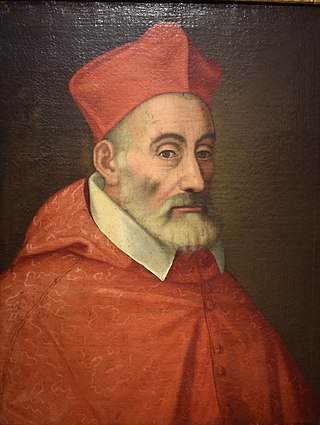This article relies largely or entirely on a single source .(August 2024) |
Henricus Canisius (1562, Nijmegen - 2 September 1610, Ingolstadt) was a Dutch canonist and historian.
This article relies largely or entirely on a single source .(August 2024) |
Henricus Canisius (1562, Nijmegen - 2 September 1610, Ingolstadt) was a Dutch canonist and historian.
Canisius was born Hendrik de Hondt ("The Dog", Latinized to Canisius), the nephew of Saint Peter Canisius. He studied at the University of Leuven, and in 1590 was appointed professor of canon law at Ingolstadt.
Canisius's works on canon law include:
A complete edition of his canonical writings appeared in Leuven in 1649 and in Cologne in 1662.
His major historical work was Antiquae Lectiones, seu antiqua monumenta ad historiam mediae aetatis illustrandam (6 volumes, Ingolstadt, 1601–1604). In 1608 a seventh volume, Promptuarium Ecclesiasticum, was added by way of supplement. The Catholic Encyclopedia describes the work as disorganized and containing "much matter of minor value"; Basnage produced a heavily edited version under the title Thesaurus Monumentorum ecclesiasticorum et historicorum (7 vols., Antwerp, 1725).
Canisius edited for the first time the Chronica Victoris Episcop. Tunnunensis et Joannis Episcop. Biclariensis, and the Legatio Luitprandi (Ingolstadt, 1600). He also produced an edition of the Historiae miscellae Pauli Diaconi (Ingolstadt, 1603).
Primate is a title or rank bestowed on some important archbishops in certain Christian churches. Depending on the particular tradition, it can denote either jurisdictional authority or (usually) ceremonial precedence.
Patrick Benedict Zimmer was a Catholic philosopher and theologian.
Jacob Keller was a German Jesuit theologian, author, and religious instructor.
Paul Laymann was an Austrian Jesuit and moralist.

Laurentius Surius was a German Carthusian hagiographer and church historian.
Josse Ravesteyn, also spelled Ravestein, was a Flemish Roman Catholic theologian.
Marguerin de la Bigne was a French theologian and patrologist and first publisher of the complete works of Isidore of Seville.
Heinrich Blyssen was a German Jesuit controversialist against the Hussites of Bohemia.
Piatus of Mons, born Jean-Joseph Loiseaux was a Belgian Catholic theologian who wrote in Latin and French.

Bernardus Papiensis, also known as Bernard of Pavia or Bernard Balbi was an Italian canonist and bishop of the Christian Church.

Gabriele Paleotti was an Italian cardinal and Archbishop of Bologna. He was a significant figure in, and source about, the later sessions of the Council of Trent, and much later a candidate for the papacy in 1590, and is now mostly remembered for his De sacris et profanis imaginibus (1582), setting out the Counter-Reformation church's views on the proper role and content of art.

Cornelius Cornelii à Lapide was a Flemish Catholic priest. He was a Jesuit and exegete of Sacred Scripture.
Vitus Pichler was an Austrian Jesuit canonist and controversial writer.
Francis Xavier Schmalzgrueber was a German Jesuit canonist.
Stephan Jakob Neher was a German Catholic priest and church historian.
Ubaldo Giraldi (1692–1775), also known by the Latin name Ubaldus A Sancto Cajetano, was an Italian canonist.
Hendrik Herp, known in Latin as Henricus Harphius, was a Dutch or Flemish Franciscan of the Strict Observance, and a writer on mysticism.

Papal appointment was a medieval method of selecting the Pope. Popes have always been selected by a council of Church fathers; however, Papal selection before 1059 was often characterized by confirmation or nomination by secular European rulers or by the preceding pope. The later procedures of the Papal conclave are in large part designed to prohibit interference of secular rulers, which to some extent characterized the first millennium of the Roman Catholic Church, e. g. in practices such as the creation of crown-cardinals and the claimed but invalid jus exclusivae. Appointment may have taken several forms, with a variety of roles for the laity and civic leaders, Byzantine and Germanic emperors, and noble Roman families. The role of the election vis-a-vis the general population and the clergy was prone to vary considerably, with a nomination carrying weight that ranged from nearly determinative to merely suggestive, or as ratification of a concluded election.

Maurus von Schenkl was a German Benedictine theologian and canonist.

Nicolaus van Esch (Eschius) was a Dutch Roman Catholic theologian and mystical writer.
![]() This article incorporates text from a publication now in the public domain : Herbermann, Charles, ed. (1913). "Henricus Canisius". Catholic Encyclopedia . New York: Robert Appleton Company.
This article incorporates text from a publication now in the public domain : Herbermann, Charles, ed. (1913). "Henricus Canisius". Catholic Encyclopedia . New York: Robert Appleton Company.